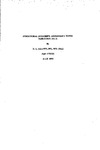STRUCTURAL INTEGRITY ASSESSMENT USING VIBRATION DATA
| dc.contributor.author | SALAWU, OLUSEGUN SAHEED | |
| dc.contributor.other | School of Engineering, Computing and Mathematics | en_US |
| dc.date.accessioned | 2013-11-05T13:35:16Z | |
| dc.date.available | 2013-11-05T13:35:16Z | |
| dc.date.issued | 1994 | |
| dc.identifier | NOT AVAILABLE | en_US |
| dc.identifier.uri | http://hdl.handle.net/10026.1/2614 | |
| dc.description.abstract |
Engineering structures need to be assessed as part of activities to ensure their continued serviceability. Global methods of assessment which also give an indication of local conditions are most attractive since they are cost effective and flexible. A suitable method with these attributes is vibration monitoring which involves relating dynamic properties, or changes in them, to the integrity of the assessed structure. The present study investigates the application of vibration testing to structural integrity assessment of civil engineering structures. A survey of existing methods of damage detection, location and quantification in structures using vibration testing was conducted. Evaluation of the performance of some of the more promising methods was conducted using both simulated and experimental data. The results revealed that the damage identification process could be enhanced if appropriate modes are used. To this end, a new function, called Modal Sensitivity Values, has been proposed for identifying damage sensitive modes to be included in damage detection and location methods. It was also found that some success could be achieved if system identification and model updating procedures are applied to the problem of damage detection in structures. The literature survey revealed that most of the available methods are not applicable to general structural systems and are often limited by the damage model assumed. A new method, called Integrity Index Damage Location method, of assessing structural integrity using vibration data has also been proposed. The method is applicable to any structure and any damage type that affects the integrity/stiffness of the structure. Performance evaluation of the method using both numerical and experimental data is presented. Full-scale forced vibration tests were conducted before and after repairs on two reinforced concrete highway bridges. The vibrator used during the tests was developed during the research project and details of its development and operation are given in the thesis. As a background to the tests, a review of full-scale dynamic testing of bridge structures was conducted. Results from the tests were used to investigate the effectiveness of forced vibration testing as an integrity monitoring tool. It was found that the repair works caused slight (less than 5%) changes in the natural frequencies while there was no definite trend in the changes to the modal damping ratios. Comparison of frequency response functions and mode shapes, using modal analysis procedures, was found to give an indication of the presence and location of the repairs. The integrity assessment method proposed was also able to identify some of the affected parts of the structures. Results from the full-scale tests were also compared with predictions from finite element analysis. Good correlation was obtained between the measured and calculated natural frequencies and mode shapes, thus enabling validation of the analytical models within limits of the model assumptions and experimental errors. The results demonstrate the importance of accurate representation of boundary conditions. They (results) also showed that the vertical stiffness of new bearings installed on one of the bridges is not as high as was assumed in the design. | en_US |
| dc.language.iso | en | en_US |
| dc.publisher | University of Plymouth | en_US |
| dc.title | STRUCTURAL INTEGRITY ASSESSMENT USING VIBRATION DATA | en_US |
| dc.type | Thesis | |
| plymouth.version | Full version: final and full version as approved by the examiners at the time of the award of your degree | en_US |
| dc.identifier.doi | http://dx.doi.org/10.24382/3861 | |
| dc.identifier.doi | http://dx.doi.org/10.24382/3861 |
Files in this item
This item appears in the following Collection(s)
-
01 Research Theses Main Collection
Research Theses Main


